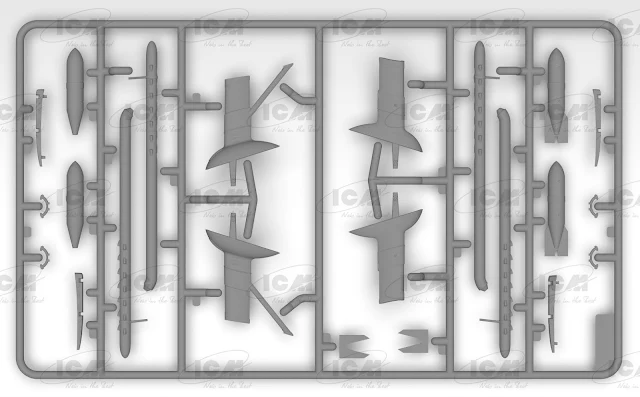This is a plastic injection kit we thought might be coming, the Fiat CR,42 "Falco" in 1/32nd scale. This time from ICM in Ukraine. We know this one will be popular with modellers, so we bring you the CAS renders of the new kit in progress, along with some info about the real thing and the Luftwaffe version in this particular boxing in our preview...
ICM's new CR. 42 LW, WWII German Luftwaffe Ground Attack Aircraft kit in development
CR. 42 LW, WWII German Luftwaffe Ground Attack Aircraft
From ICM Models
Kit No #32021
Kit No #32021
1/32nd scale
100% new moulds
ICM's Kit no #32021, the all-new tooled kit of the CR. 42 LW, WWII German Luftwaffe Ground Attack Aircraft in 1/32nd scale:
The all-new tooled kit of the CR.42 LW, WWII German Luftwaffe Ground Attack Aircraft has only seen the light so far in CAD form, but we thought we might look at some of the details in the sprues and CAD images of the completed kit to pick out a few details of the forthcoming model...
The Fiat CR.42 Falco ("Falcon", plural: Falchi) was a single-seat sesquiplane fighter developed and produced by Italian aircraft manufacturer Fiat Aviazione. It served primarily in Italy's Regia Aeronautica both before and during the Second World War.
Fiat CR.42 Falco captured during the Battle of Britain. The aircraft was salvaged following a forced landing due to an overheated engine, on the shingle beach at Orfordness, Suffolk, on 11 November 1940.
CR.42LW
The CR.42 LW was a night harassment, anti-partisan aircraft for the German Luftwaffe. The aircraft was equipped with exhaust flame dampers, a pair of 12.7 mm machine guns and underwing racks for four 50 kg bombs. 150 were built, of which 112 were accepted into service by the Luftwaffe.
Service of the CR. 42 in the Luftwaffe
Shortly following the announcement of the Italian armistice of 1943, the Luftwaffe took over the majority of Regia Aeronautica aircraft. Among these aircraft were a number of CR.42s.[86] German Rüstungs-und-Kriegsproduktion Stab took control of Italy's northern aircraft industry; consequently, an order for 200 CR.42LW (LW=Luftwaffe) was placed with Fiat for use by the Luftwaffe. In German service, the type was used to conduct nighttime harassment operations and anti-partisan roles. A number of the captured Fiats were allocated to training divisions as well. The CR.42 was nicknamed "Die Pressluftorgel" or "the Pneumatic Organ" by Luftwaffe trainee pilots, presumably because of its profusion of pneumatic systems.
One of the German units to use the CR.42 was Nachtschlachtgruppe (NSGr.) 9, based in Udine. It was tasked with fighting against partisans in the region of the Alps, Istria and Croatia. During November 1943, the 1. Staffel received its Falchi and, in January 1944, the unit was transferred to the airfield at Caselle, near Turin, to operate against partisan units in the vicinity of the Southern Alps. On 28 January, the 2. Staffel was also equipped with the CR.42. The training of German pilots took place at a school in Venaria Reale.
During February 1944, after news of the Allies' landing at Anzio, 1.Staffel and 2.Staffel, based at Centocelle Airport in Rome, attacked Allied units in southern Latium, which were conducted mostly during moonlit night raids. NSGr9 attacked enemy troops in the Monte Cassino area. The CR.42 proved to be useful as a light bomber at night, but subsequently, NSGr9 began to be equipped with the Ju 87D. 2.Staffel kept using the Fiat biplanes until mid-1944. On 31 May, the unit still had 18 Falchi, 15 of which were operational.
As a consequence of Allied raids that damaged the Fiat factory in Turin, only 150 CR.42LWs were ultimately completed, of which 112 would reach operational condition. Another German unit that used the type, both in Southern Italy and the Balkans, was Jagdgeschwader JG 107, which flew them as night fighters, fighter-bombers and fighter-trainers.
CR. 42 LW Stats...
Developed from Fiat CR.32
National origin Italy
Manufacturer Fiat Aviazione
Designer Celestino Rosatelli
First flight 23 May 1938
Introduction 1939
Retired 1948 Spanish Air Force
Primary users
Regia Aeronautica
Spanish Air Force
Belgian Air Force
Swedish Air Force
Produced c. February 1939 – Late 1943
Number built 1,817–1,819
The kit from ICM:
You can see from this first sprue the simple layout of the model. Only Seven sprues and a transparency sprue in the box, this will be an easy kit to make and hopefully, we will see plenty on the competition tables because of the ease of construction.
All transparencies are provided of course, we would think no masks included as that is not ICM's usual M.O. - A clear gunsight is also included.
A view of the CAD drawings now, A good view of the loaded hardpoints under the aircraft and the bulbous spats on the large landing gear on the real aircraft.
4a full cockpit is included, of course, hopefully, some nice detail is to be had as this is exposed to the elements...
The Fiat A.74 R.C.38 14 cylinder air-cooled radial piston engine, with 627 kW (841 hp) at 3,800 m (12,500 ft) and 2,400 rpm and the three-bladed G.50 type propeller is included upfront...
A walk around of the whole aircraft...
That is all we have on this kit so far, more as it comes close - might even get someone to build it if there is a chance - More info on this kit on the ICM Website
























